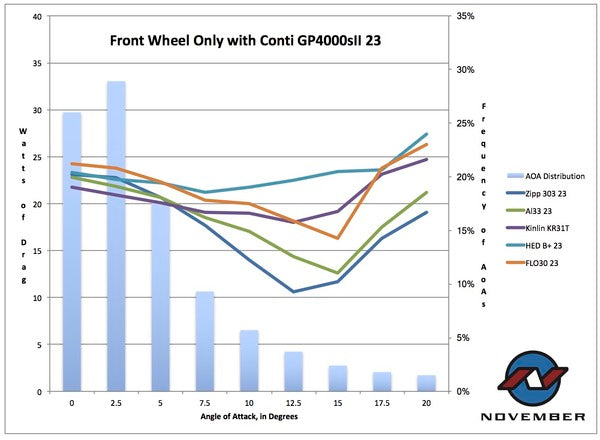This blog, and series, will be a way more difficult story to tell than I'd thought it would be.
What we'd expected was that the Zipp 303 reference wheel would be that shade faster at the heavily prevalent and thus more important narrow angles of attack (aka yaw angles), and then extend that lead out into the angles that occur with much less frequency. What actually happened was that the Al33 (our RFSW3 wheelset's rim) and the Kinlin XR31T (that we use in the FSW3) both performed better than the 303 at the most prevalent low yaw angles, starting to cede a bit at around 7.5* and going on from there.
When you do a test like this, you get a lot of data, and it takes a while to chew and digest it. What we present here is just a first, very broad, pass at things.
The blue vertical bars that you see in the graph are the amount of time the average cyclist is likely to spend encountering each wind angle during a ride. We will offer a very complete explanation of that in the next blog.
For now, we're just trying to wrap our heads around this, and make good on all the teasing that we've done. Sorry for that, hope it was worth it.
Enjoy


20 comments
So how does a 10mph crosswind compute into angle of attack? Either 90' or a 3/4 headwind. It's been 35 years since college physics and I'm a jr high history teacher now..
Darrell – We're living in the age of "let's let the internet do that works for us," so here you go: http://www.hydesailsdirect.com/Articles.asp?ID=278 Your wind speed and angle go in as "True" inputs and you're going to look at the Apparent Wind Angle in the outputs section. Don't worry about units of speed being in knots – a knot is 1.15 statute miles, but that doesn't matter so long as vehicle speed and wind speed are both in the same units.I spent a long day running through about a million different combinations in the summer of 2012 as we were working on the Rail 52.Editorially speaking, a 10mph 90* crosswind computes "rarely" into your angle of attack. Daytime average windspeed in the US is only like 8mph, and that's 30m above ground at airport towers, in unobstructed wind planes. Closer to ground level, with trees and bushes and hills and houses and blah blah blah, there isn't that much wind. 1' above the ground, in the boundary layer, where your hubs are, there's even less. Not to say 10mph doesn't happen, but it's not the norm. Dave
10mph wind ground speed is a serious wind. You would look out the window and think twice about riding that day. Wind speed tends to be greatly overestimated by amateurs.
Apparently Dave doesn't race in farm country. Winds are frequently 10-15(at the ground) with gusts of 20mph.
Scott, You're right, I don't. But the book on our methodology is extremely wide open, and I don't see any other wheels builders giving you a hot link to a calculator where you can do the math on what your angles are going to be. We're giving you all the useful information we can. It's up to you what you want to do with it or make of it, seriously. And even if it is windy, low angles of attack happen, and every wheel except SUPER deep ones and discs stall by about 15* or so (Al33 is actually a rock star for keeping it together as much as it does out that far, given its depth). So you're really only talking about a 7 to 10* window where the deeper wheels are notably better speed wise. Which also comes at the cost of handling. The Rail 52 demolished other deep (and also shallower) wheels at handling, and living in a windy coastal place (in fact I live where I do BECAUSE it's windy – I sail and windsurf) I know that even 52s get tough in big breeze and cost you energy. So the handling tradeoff probably ain't worth it anyhow.Then if you do a geographical overlay of racer density on a map, the racer density in farm country is way less. Human density is way less. Which means that statistically a smaller number of people race in farm country, and a smaller number of racer days happen in farm country. I don't have an answer for you on that one – you're getting screwed for being in a small constituency there. But it's not us who's doing the screwing. I mean Trek IS in farm country, and look at what they say. I know or at least hope that that was ribbing, but in all seriousness we have considered this thing from every freaking angle – see what I did there?Dave